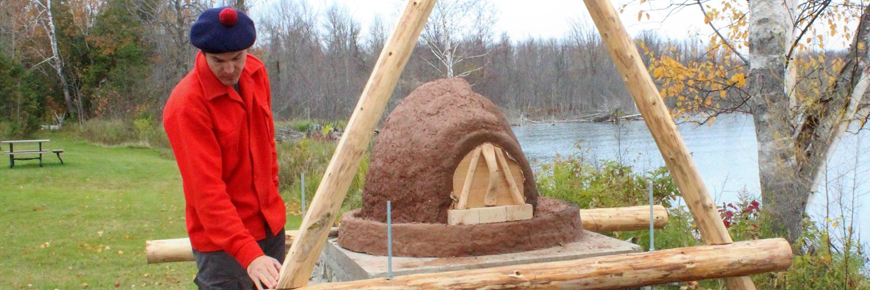
Fort St. Joseph Bake Oven Project
Fort St. Joseph National Historic Site
The use of clay bake ovens at historic Fort St. Joseph served as part of the justification for re-building a new, smaller oven. Freshly baked bread was an important ration to those living in and around the fort. So much so that, even at the first temporary fort at nearby La Pointe, gathering flat stones and clay to build an oven was one of the activities reported by Lt. Andrew Foster. A few years later, in 1802, the permanent bakehouse at Fort St. Joseph was destroyed in a fire, leaving the oven damaged and exposed to the elements. It was another year and a half before a replacement bakehouse was completed outside the fort walls, and during that time there were many complaints about the quality of the bread being produced in the damaged oven.
In 2019, Fort St. Joseph National Historic Site staff decided that a traditional wood-fired clay bake oven reconstruction would be a great addition to the site. Not only would it tie into the history of the fort and surrounding village, but it would be a low-cost, low-impact project with room to grow the interpretive baking program.
The staff decided to use the foundation of a modern stone barbecue that had fallen into disrepair for the new bake oven, and a cedar-shingled roof. Construction began with knocking down the crumbling stone barbecue to a solid course of stones, and then rebuilding it to the required height with stone and mortar. Once at the correct height, thick bars of steel were bent and mortared into the foundation, protruding at each corner to provide an anchor for when the wooden structure was ready to be made. The use of modern threaded rod, nuts, and washers means the sill logs of the roof frame can be replaced with relative ease in the future, if required. A flat surface was prepared, and the next phase of the project – the oven itself – began. The primary materials - clay, sand, and wood shavings – were gathered from sources located on St. Joseph Island, thanks to generous donations from local residents. Staff and volunteers got to stomp and mix the clay and sand together in proper proportions, making the ‘cobb’ for each layer of the oven.
After the base of the oven was established (Figure 1), a ring of cobb encircled insulating material and the firebricks that would become the floor of the oven, defining its size and shape, and making a foundation for building up the dome. Next, a cedar splint form was built to match the size and shape of plans for the interior chamber of the oven (Figure 2). Care was taken to get the ratio between the height of the interior dome and the height of the door just right, so the fire would be able to breath when the oven was being heated for use. Over the cedar splint form, the first layer of cobb was built up (Figure 3). This inner layer contained only sand and clay in the mix to become a thermal mass, and hold heat effectively.
The second layer that went on top of the sand/clay consisted of adding thin wood shavings to the mostly clay mixture, thus creating air pockets to act as insulation and hold heat within the oven. Finally, a thin, smooth layer covered over the rough surface of the insulation, adding the finishing touches to the shape and appearance of the oven.
In order to get the oven ready to use, the clay had to be dried until it was hard all the way through each layer. To accomplish this, small fires were lit inside the oven, the first one burning away the cedar splint basket, and subsequent fires over several days burning longer and hotter, driving the moisture out of the clay. Once completely dry, a clay oven will last many years if wet weather is kept away – which is why a roof was a necessary part of the project!
The final phase of the project, which began in Fall 2020, was the log-framed, cedar-shingled roof. Local cedar logs were brought to the site and prepared with a hand saw, chisel, and axe. Once two A-frames had been erected and secured to the threaded rod anchored in the stone base, rough sawn planks were nailed across the frames horizontally (Figure 4). On top of these planks, split cedar shingles were installed leaving the oven protected and ready for baking.
Beginning in 2021, as part of the site’s 225th commemoration, the bake oven has been fired every Sunday to bake bread and other treats using historic ingredients, tools and techniques of bakers in the late 18th century (Figure 5). The oven serves as a focal point in the interpretive and demonstration area, providing a glimpse into one important aspect of historic life at Fort St. Joseph.
The construction of the bake oven was aided immensely by the efforts of volunteers from the St. Joseph Island community. Without their time, skill, muscle, and materials, the bake oven would not have become such a vital addition to the historic program at Fort St. Joseph. Cheers to many more loaves to come! (Figure 6)






Related links
- Date modified :